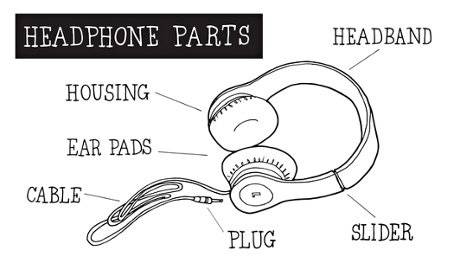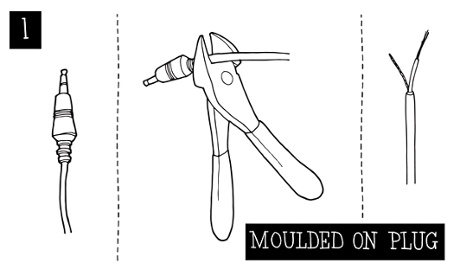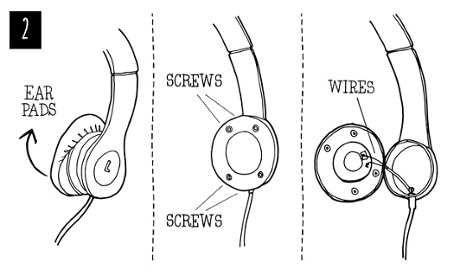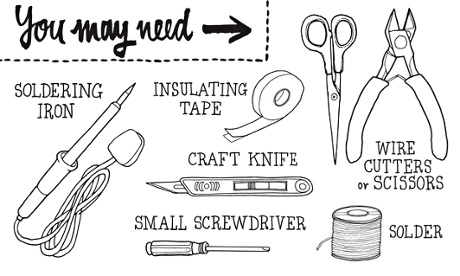Things you will need to mend* broken headphones. Illustration: Emma McGowan
to mend = réparer
You will need:
small screwdriver
= petit tournevis
wire cutters or scissors = pince coupante ou ciseaux
soldering iron and solder (or a friend who has these) = un fer à souder et de la brasure
craft knife or similar sharp blade
= cutter ou lame coupante
plastic self-adhesive insulating tape = ruban adhésif
A pair of headphones is made of:
a plug* which plugs into the socket* on your MP3 player, mobile phone or whatever, which connects to ...
a lead* with some wires* in it which connects to ...
the headphones/earbuds/earpieces themselves
a plug = une prise (de courant) (mâle), une fiche
a socket = une prise (de courant) (femelle)
a lead = un fil, cordon
wire = fil électrique

Identifying the problem
If you have a pair of headphones that no longer work, you need to ask yourself the following questions:
to drop = laisser tomber, lâcher
to come loose = se décoincer, se desserrer, se débrancher
to chew = mâchouiller, mâchonner
a break = une coupure
to get yanked = être arraché/ tiré d'un coup sec
to pull out = arracher, déboiter
crackly = crépitant, grésillant
faint = faible
somehow = d'une manière ou d'une autre, pour une raison ou pour une autre
worse = pire
to move (things) around = déplacer, remuer
to wiggle = agiter, remuer
ditto = idem
The most common problems involve one or more of the wires inside the lead becoming disconnected either in the plug (see 1, below), in the headphones (2) or in the lead itself (3).
Fixing the problem*
(1) In some headphones the plug is moulded-on*. In other words, the lead and the plug are not separate: just one continuous piece of plastic. If the wires inside a moulded-on plug break, you’ll probably have to cut the plug off the lead using your wire cutters or scissors (simply cut off the lead where it meets the plug) buy a new plug of the same type as the old one, fix* the new plug on to the lead: this will involve stripping* the insulation* off the lead then soldering* the wires on to the plug.
to fix a problem = résoudre un problème
moulded-on = moulé, fondu
to fix = fixer
to strip = dégarnir
the insulation = l'isolation
to solder = souder

If the plug isn’t moulded on, you should be able to unscrew* the back of the plug to get at the wires inside the lead: in this case, if one or more of the wires has become disconnected inside the plug then they will need to be soldered back* on.
to unscrew = dévisser
to solder back = re-souder
(2) Usually taking a pair of headphones apart* is fairly simple: often the padding* just pulls off* but you may need a small screwdriver such as a size 0 crosshead* to get the tiny* screws* out. You can get these from most DIY or hardware shops*. Once* you’ve disassembled the headphone part, you will be able to see the tiny wires going from the lead to the headphones.
to take apart = démonter, désassembler
padding = coussinet
to pull off = enlever, ôter
crosshead = cruciforme
tiny = minuscule
a screw = une vis
a DIY or hardware shop = un magasin de bricolage ou une quincaillerie
once = une fois que

If you can see that one or more of these has become disconnected, then that’s your problem: you need to reattach it.
(3) Over time, the wires can break somewhere inside* the lead. This kind of break is more difficult to track down*, but sometimes you can see the damage or feel a kink* or break in the lead. In this case, you need to carefully* cut open the lead insulation* where the break has happened, find the broken wire*, then rejoin the broken wire ends by soldering*.
inside = à l'intérieur
to track down = finir par localiser
to feel a kink = sentir un défaut/ noeud
carefully = soigneusement
the lead insulation = l'isolation du cordon
the broken wire = le fil (électrique) coupé/ cassé
by soldering = par une soudure
Soldering uses a special molten* metal alloy* (“solder”) which is melted* by a soldering iron to stick wires to connections or to join* two pieces of wire together if they’re broken. You may need to carefully strip the insulation off the ends* of the wires using wire cutters or scissors to reveal bare* metal before soldering. (If you don’t have a soldering iron, you could try asking at an electronics repair shop, or better still, attend your local repair café if you know of one.) Once you’ve rejoined the broken wires you can wrap* some insulating tape round the join, then finish off by wrapping* some more insulating tape round the lead to neaten up* the repair and avoid further damage*.
molten = en fusion
an alloy = un alliage
to melt = fondre
to stick = coller
to join = assembler, relier
the ends = les extrémités
bare = à nu
to wrap = envelopper, enrouler, emballer
to neaten up = rendre propre
further damage = de plus amples dégâts
One last thing: some headphones use a type of wire which has no visible plastic insulation around it, instead the metal is covered with a very thin layer* of coloured varnish* which provides the insulation. To solder this, you need to heat* the end of the wire with the soldering iron until the coloured insulation is all burned off* (avoiding inhaling* the fumes) then solder the resulting bare metal wire as before.
a thin layer = une mince couche/ pellicule
coloured varnish = vernis coloré
to heat = chauffer
to burn off = brûler au chalumeau
to inhale = respirer
David Lukes
theguardian.com, Friday 23 May 2014 10.00

/image%2F1036343%2F20140708%2Fob_30eacb_img-0417.JPG)

/http%3A%2F%2Fstatic.guim.co.uk%2Fsys-images%2FGuardian%2FPix%2Fpictures%2F2014%2F5%2F22%2F1400759700921%2F4bfd4bec-37e0-4c5a-adb2-e8fdf5de03a3-460x276.jpeg)



Commenter cet article